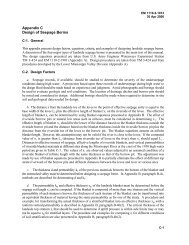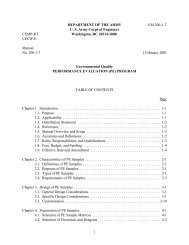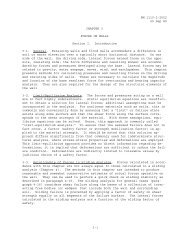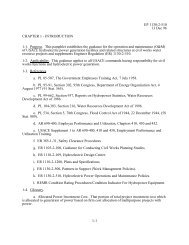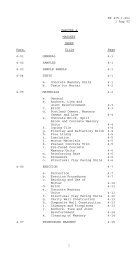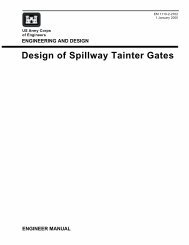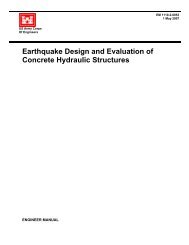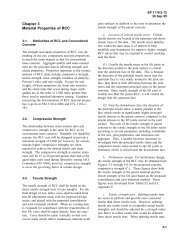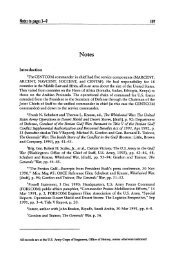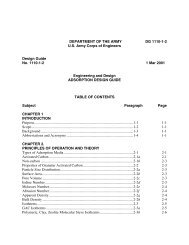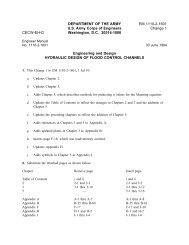Chapter 5 - Publications, US Army Corps of Engineers
Chapter 5 - Publications, US Army Corps of Engineers
Chapter 5 - Publications, US Army Corps of Engineers
You also want an ePaper? Increase the reach of your titles
YUMPU automatically turns print PDFs into web optimized ePapers that Google loves.
EM 111O-2-17O1<br />
31 Dec 1985<br />
(usually 115 percent <strong>of</strong> nameplate). At the present time, only a<br />
single rated capacity value is specified, and this value includes<br />
overload characteristics (see Section 6-lb). <strong>Chapter</strong> 6 gives<br />
additional information on plant size selection.<br />
(1) Maximum and minimum turbine discharge and the turbine~s<br />
usable head range establish limits on the amount <strong>of</strong> energy that can be<br />
developed at a site. In making energy computations, it is necessary<br />
to check to insure that the net head and usable discharge values for<br />
each time interval fall within the allowable range for the type <strong>of</strong><br />
turbines being considered, so these values must be identified.<br />
Sections 2-6 and 5-5 provide general information on turbine characteristics<br />
and turbine selection. Following is some specific data on<br />
discharge and head ranges for the various types <strong>of</strong> turbines.<br />
(2) In planning studies, plant size is <strong>of</strong>ten specified initially<br />
in terms <strong>of</strong> hydraulic capacity. The hydraulic capacity would also be<br />
the plant~s maximum discharge, and in most cases can be assumed to be<br />
the same as the plant’s rated discharge (see Section 6-lb(8)). The<br />
maximum (or rated) discharge <strong>of</strong> individual units would be defined by<br />
the number and size <strong>of</strong> the units (see Section 6-6f).<br />
(3) Cavitation problems and the possibility <strong>of</strong> rough operation<br />
preclude generation below a minimum discharge (see Section 5-5d), and<br />
the minimum discharge for a single unit establishes the plant?s<br />
minimum allowable power discharge. Table 5-1 lists factors for<br />
computing minimum discharges for different types <strong>of</strong> turbines given a<br />
units rated discharge. These values can be used for initial power<br />
studies, but once a unit design has been selected, the specific<br />
minimum discharge characteristics <strong>of</strong> that unit should be used.<br />
(4) Likewise, a turbine is only capable <strong>of</strong> operating<br />
satisfactorily over a limited head range (Section 5-5b)~ and this<br />
should be reflected in energy studies. For preliminary studies, the<br />
maximum head ranges listed in Table 5-1 should be used. These ranges<br />
are only approximate. Once a unit design has been selected, the<br />
specific head range characteristics <strong>of</strong> that unit should be used<br />
instead.<br />
Je Wlcfs Curve. When hand routing techniques and certain<br />
computer programs are used to evaluate the energy output <strong>of</strong> a storage<br />
project, kW/cfs versus elevation and kW/cfs versus head curves are<br />
sometimes used to simplify the analysis. These curves account for the<br />
variation <strong>of</strong> powerplant efficiency with head, and the kW/cfs versus<br />
elevation curves account for head loss and tailwater elevation as<br />
5-32




